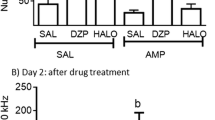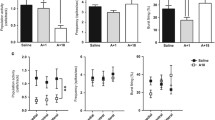Abstract
The caudate nucleus or the tuberculum olfactorium of the rat was lesioned by bilateral stereotaxic injection of 6-hydroxydopamine. The degree of dopamine depletion was assessed by a sensitive regional dopamine assay and revealed severe depletions in the lesioned areas. The locomotor response to a low dose of d-amphetamine was not modified by either lesion. However, the stereotypy response to a high dose of amphetamine was abolished by the caudate lesion. The stereotypy response was not modified by lesion to the tuberculum olfaotorium. Neither lesion abolished the stereotypy response to apomorphine. The results therefore demonstrate that amphetamine is an indirect sympathomimetic agent and further emphasize the critical role of the dopaminergic nigrostriatal pathway in amphetamine induced stereotypy.
Similar content being viewed by others
References
Andén, N.-E., Fuse, K., Hamberger, B., Hokfelt, T.: A quantitative study of the nigrostriatal dopamine neuron system in the rat. Acta physiol. scand. 67, 306–312 (1966)
Andén, N.-E., Rubenson, A., Fuxe, K., Hokfelt, T.: Evidence for dopamine receptor stimulation by apomorphine. J. Pharm. Pharmacol. 19, 627–629 (1967)
Costall, B., Naylor, R. J.: Extrapyramidal and mesolimbic involvement with the Stereotypic activity of d- and l-amphetamine. Europ. J. Pharmacol. 25, 121–129 (1974)
Creese, I., Iversen, S. D.: Amphetamine response after dopamine neurone destruction. Nature New Biol. 238, 247–248 (1972)
Creese, I., Iversen, S. D.: Blockage of amphetamine induced motor stimulation and stereotypy in the adult rat following neonatal treatment with 6-hydroxydopamine. Brain Res. 55, 369–382 (1973)
Cuello, A. C., Hiley, R., Iversen, L. L.: Use of Catechol-O-methyltransferase for the enzyme radiochemical assay of dopamine. J. Neurochem. 21, 1337–1340 (1973)
Divac, I.: Drug-induced syndromes in rats with large, chronic lesions in the corpus striatum. Psychopharmachologia (Berl.) 27, 171–178 (1972)
Ernst, A. M.: Chemical stimulation of central dopaminergic receptors in the striatal body of rats. In: Proceedings of the Twelfth meeting of the European Society for the study of drug toxicity, Excerpta Medica International Congress Series 220, 18–23 (1970)
Ernst, A. M.: The role of biogenic amines in the extrapyramidal system. Acta physiol. Pharmacol. neerl. 15, 141–154 (1969)
Fog, R., Randrup, A., Pakkenberg, H.: Lesions in corpus striatum and cortex of rat brains and the effect on pharmacologically induced stereotyped, aggressive and cataleptic behavior. Psychopharmacologia (Berl.) 18, 346–356 (1970)
Fog, R., Pakkenberg, H.: Behavioural effects of dopamine and p-hydroxyamphet-amine injected into corpus striatum of rats. Exp. Neurol 31, 75–86 (1971)
Iversen, S. D.: The effect of surgical lesions to frontal cortex and substantia nigra on amphetamine responses in rat. Brain Res. 8, 295–311 (1971)
McKenzie, G. M.: Role of the tuberculum olfactorium in stereotyped behaviour induced by apomorphine in the rat. Psychopharmachologia (Berl.) 23, 212–219 (1972)
Naylor, R. J., Olley, J. E.: Modification of the behavioural changes induced by amphetamine in the rat by lesions in the caudate nucleus, the caudate-putamen and globus pallidus. Neuropharmacology 11, 91–99 (1972)
Peligrino, L. J., Cushman, A. J.: A stereotaxic atlas of the rat brain. New York: Appleton-Century-Crofts 1967
Randrup, A., Munkvad, I.: Role of catecholamines in the amphetamine excitatory response. Nature (Lond.) 211, 540 (1966)
Randrup, A., Munkvad, I.: Biochemical, anatomical and psychological investigations of stereotyped behaviour induced by amphetamines. In: Amphetamines and related compounds. E. Costa and S. Garattini, Eds., pp. 695–713. New York: Raven Press 1970
Scheel-Kruger, J.: Some aspects of the mechanism of action of various stimulant amphetamine analogues. Psychiat. Neurol. Neurochir. (Amst.) 75, 179–192 (1972)
Schoenfeld, R., Uretsky, N.: Altered response to apomorphine in 6-hydroxydopamine treated rats. Europ. J. Pharmacol. 19, 115–118 (1972)
Simpson, B. A., Iversen, S. D.: The effects of substantia nigra lesions on the locomotor and stereotypy responses to amphetamine. Nature (Lond.) 230, 30–32 (1971)
Stolk, J. M., Rech, R. H.: Antagonism of d-amphetamine by α-methyl-l-tyrosine. Behavioural evidence for the participation of catecholamine stores and synthesis in the amphetamine stimulant response. Neuropharmacology 9, 249–263 (1970)
Taylor, K. M., Snyder, S. H.: Differential effects of d- and l-amphetamine on behavior and on the catecholamine dispostion in dopamine and norepinephrine containing neurons of rat brain. Brain Res. 28, 295–309 (1971)
Teitelbaum, P., Epstein, A. N.: The lateral hypothalamic syndrome: Recovery of feeding and drinking after lateral hypothalamic lesions. Physiol. Rev. 69, 74–90 (1962)
Ungerstedt, U.: Stereotaxic mapping of the monoamine pathways in the rat brain. Acta physiol. scand., Suppl. 367, 1–48 (1971 a)
Ungerstedt, U.: Striatal dopamine release after amphetamine or nerve degeneration. Acta physiol. scand., Suppl. 367, 49–68 (1971 b)
Ungerstedt, U.: Postsynaptic supersensitivity after 6-hydroxydopamine induced degeneration of the nigro-striatal dopamine system. Acta physiol. scand., Suppl. 367, 69–93 (1971 c)
Ungerstedt, U.: Histochemical studies on the effects of intercerebral and intraventricular injections of 6-hydroxydopamine on monoamine neurones in the rat brain. In: 6-Hydroxydopamine and catecholamine neurones. T. Malfors and H. Thoenen, Eds., pp. 101–127. Amsterdam: North Holland Publ. 1971 d
Ungerstedt, U.: Adipsia and aphagia after 6-hydroxydopamine induced degeneration of the nigro-striatal dopamine system. Acta physiol. scand., Suppl. 367, 95–122 (1971 e)
Ungerstedt, U., Butcher, L. L., Butcher, S. G., Andén, N.-E., Fuxe, K.: Direct chemical stimulation of dopaminergic mechanisms in the neostriatum of the rat. Brain Res. 14, 461–471 (1969)
Uretsky, N. J., Iversen, L. L.: Effects of 6-hydroxydopamine on catecholamine containing neurones in the rat brain. J. Neurochem. 17, 269–278 (1970)
Uretsky, N. J., Schoenfeld, R. I.: Effect of l-dopa on the locomotor activity of rats pretreated with 6-hydroxydopamine. Nature New Biol. 234, 157–159 (1971)
Weissman, A., Koe, K., Tenen, S.: Antiamphetamine effects following inhibition of tyrosine hydroxylase. J. Pharmacol. exp. Ther. 151, 339–352 (1966)
Author information
Authors and Affiliations
Rights and permissions
About this article
Cite this article
Creese, I., Iversen, S.D. The role of forebrain dopamine systems in amphetamine induced stereotyped behavior in the rat. Psychopharmacologia 39, 345–357 (1974). https://doi.org/10.1007/BF00422974
Received:
Revised:
Issue Date:
DOI: https://doi.org/10.1007/BF00422974




